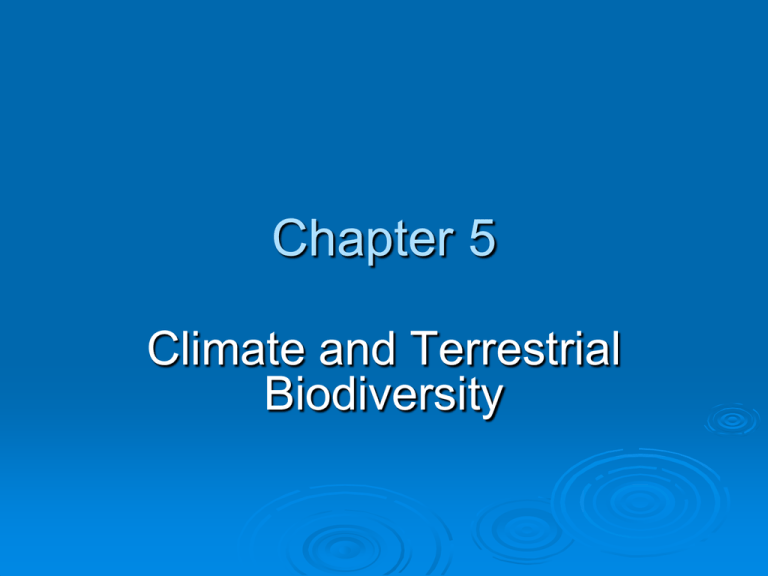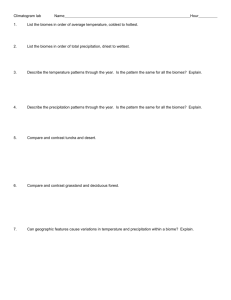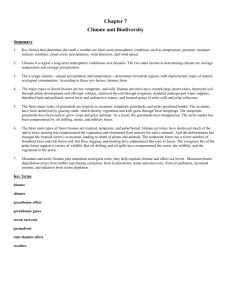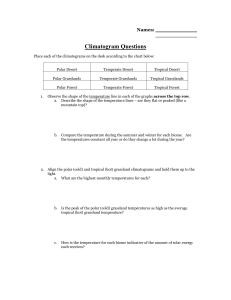Ch 5 - Climate and Terrestrial Biodiversity
advertisement

Chapter 5 Climate and Terrestrial Biodiversity Chapter Overview Questions What factors the earth’s climate? How does climate determine where the earth’s major biome’s are found? What are the major types of desert biomes? What are the major types of grassland biomes? Chapter Overview Questions (cont’d) What are the major types of forest and mountain biomes? How have human activities affected the world’s desert, grassland, forest, and mountain biomes? Core Case Study Blowing in the Wind: A Story of Connections Wind connects most life on earth. Keeps tropics from being unbearably hot. Prevents rest of world from freezing. Figure 5-1 Weather and climate Weather is a local area’s short-term physical conditions such as temperature and precipitation. Climate is a region’s average weather conditions over a long time. Latitude and elevation help determine climate. Average temp and average precipitation are two main factors. “Climate is what we expect, weather is what we get” – Mark Twain. Earth’s Current Climate Zones Figure 5-2 Distributing Heat Global air circulation is affected by the uneven heating of the earth’s surface by solar energy, seasonal changes in temperature and precipitation. Four major factors determine global air circulation patterns: Uneven heating of the earth’s surface by the sun Seasonal changes in temperature and precipitation Rotation of the earth on its axis causes Coriolis effect Properties of air, water and land (convection currents) Figure 5-3 Spring (sun aims directly at equator) Winter (northern hemisphere 23.5 ° tilts away from sun) Solar radiation Summer (northern hemisphere tilts toward sun) Fall (sun aims directly at equator) Fig. 5-3, p. 102 Coriolis Effect Global air circulation is affected by the rotation of the earth on its axis. Atmospheric regions called cells are made from belts of prevailing winds (major winds continuously blowing) that distribute heat and moisture Six giant convection cells on earth Figure 5-4 Cell 3 North Cold, dry air falls Moist air rises — rain Polar cap Arctic tundra Evergreen 60°coniferous forest Temperate deciduous forest and grassland 30°Tropical Desert Cell 2 North Cool, dry air falls Cell 1 North deciduous forest 0°Equator Tropical deciduous 30°forest Tropical rain forest Desert Temperate deciduous 60°forest and grassland Cell 1 South Cool, dry air falls Cell 2 South Polar cap Cold, dry air falls Moist air rises, cools, and releases Moisture as rain Moist air rises — rain Cell 3 South Fig. 5-6, p. 103 LOW PRESSURE Cool, dry air HIGH PRESSURE Heat released radiates to space Condensation Falls, is compressed, warms and precipitation Rises, expands, cools Warm, dry air Hot, wet air Flows toward low pressure, picks up moisture and heat HIGH Moist surface warmed PRESSURE by sun LOW PRESSURE Fig. 5-5, p. 103 Ocean Currents Ocean currents influence climate by distributing heat from place to place and mixing and distributing nutrients. Flow clockwise in northern hemisphere, counterclockwise in southern. Gulf Stream transports 25 times more water than all of the world’s rivers combined. Figure 5-7 (a) Rays of sunlight penetrate the lower atmosphere and warm the earth's surface. (b) The earth's surface absorbs much of the incoming solar radiation and degrades it to longer-wavelength infrared (IR) radiation, which rises into the lower atmosphere. Some of this IR radiation escapes into space as heat, and some is absorbed by molecules of greenhouse gases and emitted as even longer-wavelength IR radiation, which warms the lower atmosphere. (c) As concentrations of greenhouse gases rise, their molecules absorb and emit more infrared radiation, which adds more heat to the lower atmosphere. Fig. 5-7, p. 104 Ocean Currents: Distributing Heat and Nutrients Global warming: Considerable scientific evidence and climate models indicate that large inputs of greenhouse gases from anthropogenic activities into the troposphere can enhance the natural greenhouse effect and change the earth’s climate in your lifetime. Topography and Local Climate: Land Matters Interactions between land and oceans and disruptions of airflows by mountains and cities affect local climates. Figure 5-8 Biomes Different climates lead to different communities of organisms, especially vegetation. Biomes – large terrestrial regions characterized by similar climate, soil, plants, and animals. Each biome contains many ecosystems whose communities have adapted to differences in climate, soil, and other environmental factors. Climates have changed over the earth’s history. Temperature, precipitation, and soil type are the most important factors in producing the type of biome. Biomes are not uniform; they consist of a mosaic of patches Tropic of Cancer Equator High mountains Polar ice Polar grassland (arctic tundra) Temperate grassland Tropical grassland (savanna) Chaparral Coniferous forest Temperate deciduous forest Tropical forest Desert Tropic of Capricorn Fig. 5-9, p. 106 Polar Tundra Subpolar Temperate Coniferous forest Desert Deciduous Forest Grassland Chaparral Tropical Desert Rain forest Savanna Tropical seasonal forest Scrubland Fig. 5-10, p. 107 Effects of elevation and latitude on biomes Parallel changes occur in vegetation type occur when we travel from the equator to the poles or from lowlands to mountaintops. Figure 5-11 DESERT BIOMES Deserts are areas where evaporation exceeds precipitation. Deserts have little precipitation and little vegetation. Found in tropical, temperate and polar regions. Desert plants have adaptations that help them stay cool and get enough water. Cover about 30% of the earth’s land surface DESERT BIOMES Variations in annual temperature (red) and precipitation (blue) in tropical, temperate and cold deserts. Figure 5-12 Freezing point Month Mean monthly precipitation (mm) Mean monthly temperature (C) Tropical Desert Fig. 5-12a, p. 109 Freezing point Month Mean monthly precipitation (mm) Mean monthly temperature (C) Temperate Desert Fig. 5-12b, p. 109 Freezing point Month Mean monthly precipitation (mm) Mean monthly temperature (°C) Polar Desert Fig. 5-12c, p. 109 Deserts The flora and fauna in desert ecosystems adapt to their environment through their behavior and physiology. Adaptations include two main themes: Beat the heat Every drop of water counts Figure 5-13 Desert adaptations Plants: Waxy leaves Deep roots Store water Open stomatta only at night Animals: Hide during day Thick outer covering to prevent water loss Get water from dew or food Fragile ecosystems Soil nutrients take a long time to recover GRASSLANDS AND CHAPARRAL BIOMES Variations in annual temperature (red) and precipitation (blue). Figure 5-14 Freezing point Month Mean monthly precipitation (mm) Mean monthly temperature (C) Tropical grassland (savanna) Fig. 5-14a, p. 112 Freezing point Month Mean monthly precipitation (mm) Mean monthly temperature (C) Temperate grassland Fig. 5-14b, p. 112 Freezing point Month Mean monthly precipitation (mm) Mean monthly temperature (C) Polar grassland (arctic tundra) Fig. 5-14c, p. 112 GRASSLANDS AND CHAPARRAL BIOMES Grasslands (prairies) occur in areas too moist for desert and too dry for forests. Savannas are tropical grasslands with scattered tree and herds of hoofed animals. Migrations to find food and water in response to seasonal changes. Plants can survive extreme moisture and temperature levels. Temperate Grasslands The cold winters and hot dry summers have deep and fertile soil that make them ideal for growing crops and grazing cattle. Short-grass and tallgrass praries. Figure 5-15 Golden eagle Pronghorn antelope Grasshopper sparrow Coyote Grasshopper Blue stem grass Prairie dog Bacteria Fungi Prairie Coneflower Producer to primary consumer Primary to secondary consumer Secondary to higher-level consumer All producers and consumers to decomposers Fig. 5-15, p. 113 Polar Grasslands Polar grasslands are covered with ice and snow except during a 6-8 week summer. Permafrost can form: underground soil that stays frozen for more than 2 consecutive years. Global warming has melted some permafrost, releasing CH4. Soil recovers slowly; biome is fragile. Figure 5-17 Chaparral Chaparral has a moderate climate but its dense thickets of spiny shrubs are subject to periodic fires. Thin soil, not very fertile. Figure 5-18 FOREST BIOMES Variations in annual temperature (red) and precipitation (blue) in tropical, temperate, and polar forests. Forests have enough precipitation to support stands of trees and are found in tropical, temperate, and polar regions. Figure 5-19 Freezing point Month Mean monthly precipitation (mm) Mean monthly temperature (C) Tropical rain forest Fig. 5-19a, p. 116 Freezing point Month Mean monthly precipitation (mm) Mean monthly temperature (C) Temperate deciduous forest Fig. 5-19b, p. 116 Freezing point Month Mean monthly precipitation (mm) Mean monthly temperature (C) Polar evergreen coniferous forest (boreal forest, taiga) Fig. 5-19c, p. 116 Tropical Rain Forest Tropical rain forests have heavy rainfall and a rich diversity of species. Found near the equator. Have year-round uniformity warm temperatures and high humidity. Vast amount of biodiversity. High net primary productivity. 2% of earth’s land surface, half of the earth’s terrestrial species reside here. Figure 5-20 Tropical Rain Forest Filling such niches enables species to avoid or minimize competition and coexist Figure 5-21 Temperate Deciduous Forest Most of the trees survive winter by dropping their leaves, which decay and produce a nutrientrich soil. Figure 5-22 Evergreen Coniferous Forests Consist mostly of cone-bearing evergreen trees that keep their needles year-round to help the trees survive long and cold winters. Figure 5-23 Temperate Rain Forests Coastal areas support huge cone-bearing evergreen trees such as redwoods and Douglas fir in a cool moist environment. Figure 5-24 MOUNTAIN BIOMES High-elevation islands of biodiversity Often have snow-covered peaks that reflect solar radiation and gradually release water to lowerelevation streams and ecosystems. Plants hold back erosion. Contain majority of earth’s forests. Figure 5-25 Human impact Human activities have damaged or disturbed more than half of the world’s terrestrial ecosystems. Humans have had a number of specific harmful effects on the world’s deserts, grasslands, forests, and mountains. Humans use, waste, or destroy 10-55% of the net primary productivity of earth’s terrestrial ecosystems. 60% of the world’s major terrestrial ecosystems are being degraded/used unsustainably. Natural Capital Degradation Desert Large desert cities Soil destruction by off-road vehicles Soil salinization from irrigation Depletion of groundwater Land disturbance and pollution from mineral extraction Fig. 5-26, p. 123 Natural Capital Degradation Grasslands Conversion to cropland Release of CO2 to atmosphere from grassland burning Overgrazing by livestock Oil production and off-road vehicles in arctic tundra Fig. 5-27, p. 123 Natural Capital Degradation Forests Clearing for agriculture, livestock grazing, timber, and urban development Conversion of diverse forests to tree plantations Damage from off-road vehicles Pollution of forest streams Fig. 5-28, p. 124 Natural Capital Degradation Mountains Agriculture Timber extraction Mineral extraction Hydroelectric dams and reservoirs Increasing tourism Urban air pollution Increased ultraviolet radiation from ozone depletion Soil damage from off-road vehicles Fig. 5-29, p. 124




